Crafting a Compelling Ecommerce Content Marketing Strategy


Crafting a Compelling Ecommerce Content Marketing Strategy
Get The Print Version
Tired of scrolling? Download a PDF version for easier offline reading and sharing with coworkers.
A link to download the PDF will arrive in your inbox shortly.
In 1885, Mark Twain published the Adventures of Huckleberry Finn. Grover Cleveland was inaugurated as president of the United States. The Statue of Liberty arrived in New York City…
And content marketing was born.
John Deere released its first issue of its magazine, “The Furrow,” to position themselves as an authority in the agricultural space by providing information and advice to farmers. (A furrow, as I found out after looking it up, is a trench made by a plow for irrigation and planting seeds.)
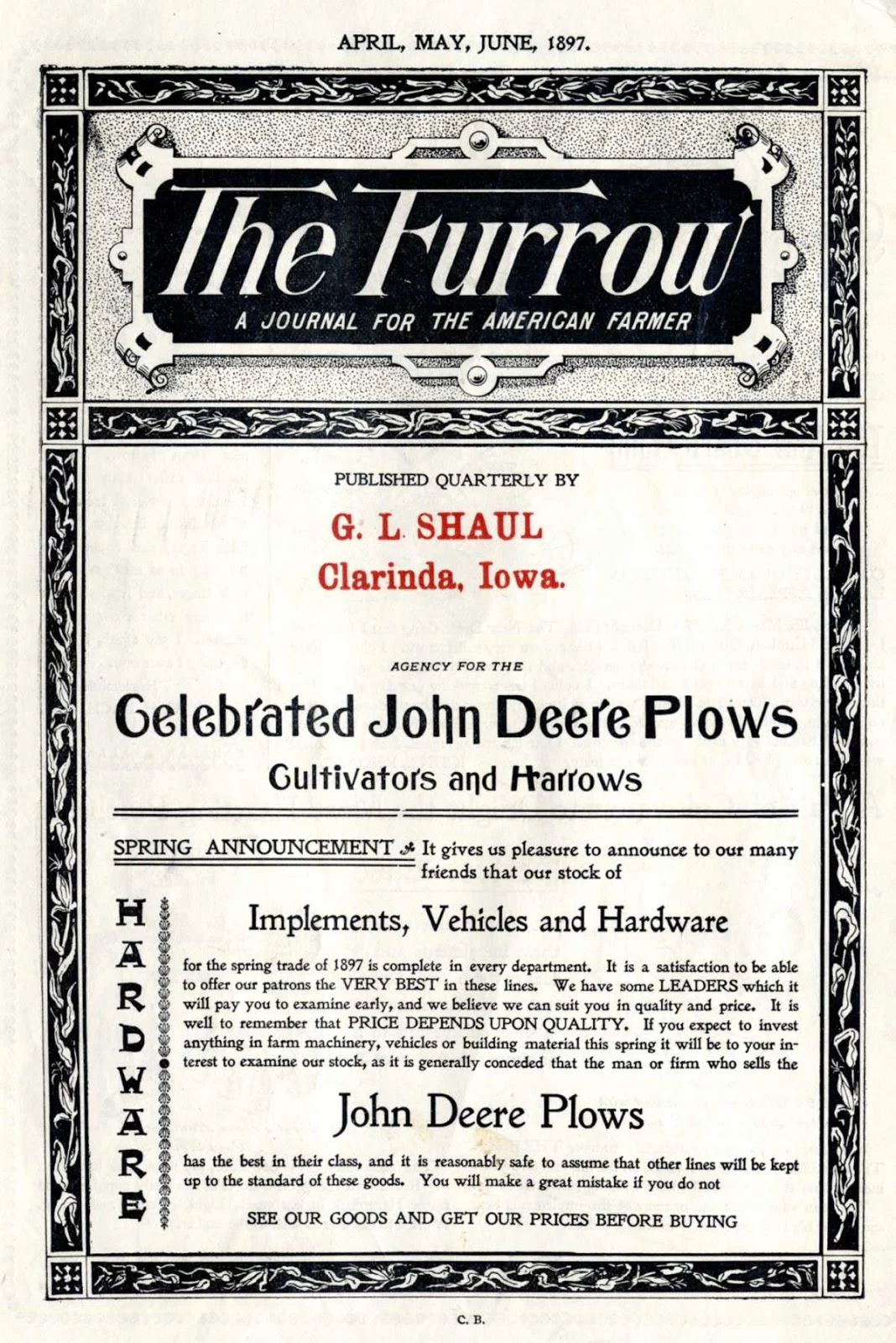
Source: Contently__, where you can read more about the history of The Furrow, and in which the magazine is referred to as “the agrarian version of Rolling Stone.”
Despite the changes in technology, advances in understanding human psychology, and growing consumer expectations, the cornerstone of content marketing remains the same: to provide valuable content without — or with only a touch of — a sales pitch in order to build authority, community, and trust.
Content marketing caught on fast and has stuck with us over the last 135 years because it works.
In fact, even The Furrow is still around! What has changed is that marketers have refined their processes, learned to become more strategic and focused, and improved ways to measure the value of their efforts.
Content marketing isn’t easy. But with stalwart commitment and a lot of elbow grease, it is more than possible. So let’s fast-forward 135 years to look at the state of content marketing in 2020 and how you can build a strategy engine that works for your business.
What is Content Marketing?
Content marketing focuses on the creation and distribution of content to attract and retain customers. It’s one form of inbound marketing, which Hubspot defines as a strategy to “attract prospects and customers to your website.”
In other words, it brings users to you, instead of you going to them through direct marketing, social advertising, search engine marketing, and display advertising.
70% of your audience prefers to learn about products through content they seek out — not ads that are served to them.
Brands today are investing in content marketing more than ever before. 59% of respondents to a mid-2018 survey reported that they expected to increase their content marketing budgets between 2019-2020.
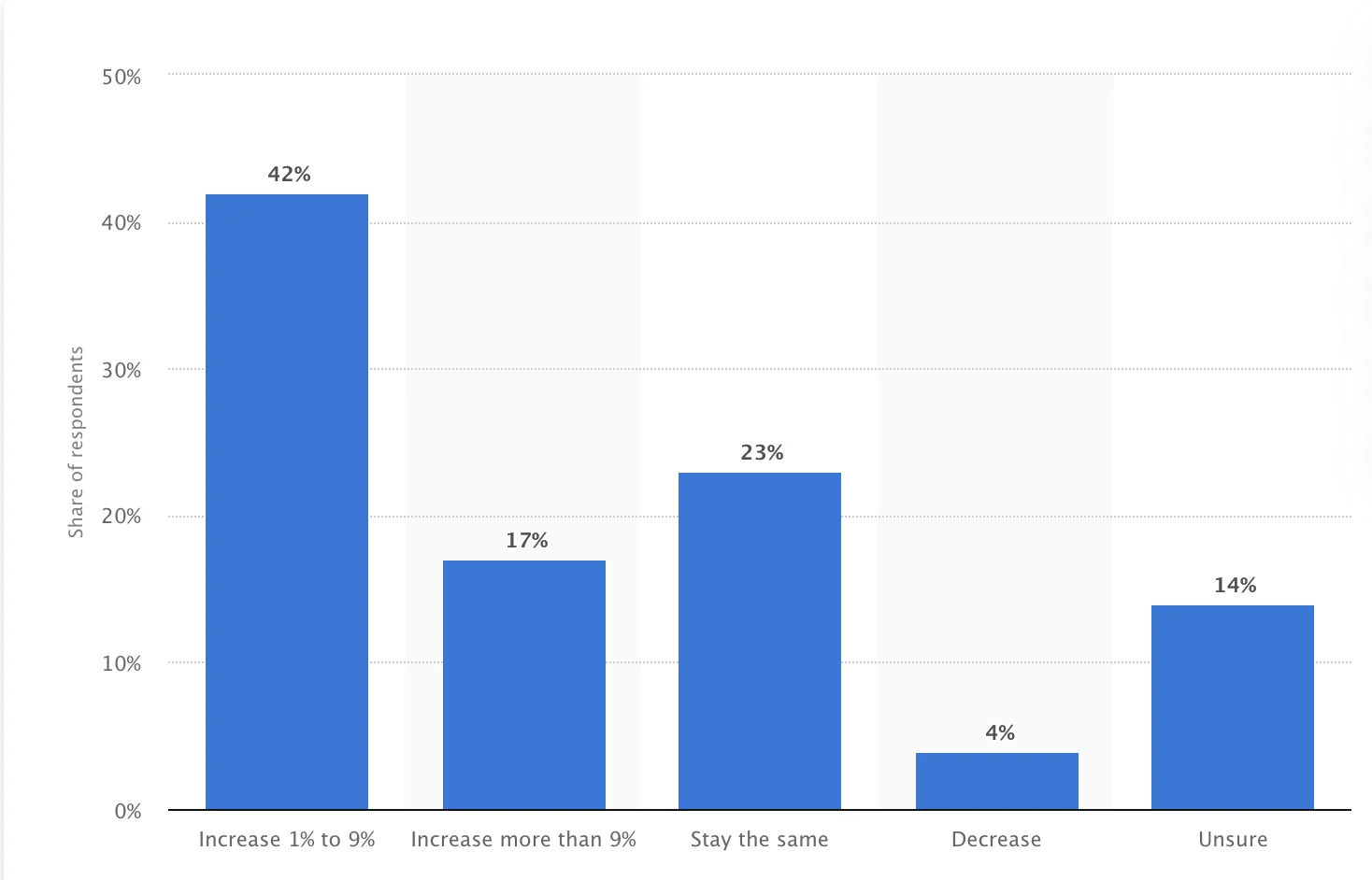
Source: Statista
The goal of any content marketing effort should be to answer your audience’s questions where they’re looking for them — via a search engine, social media network, or other — in a way that’s tailored for each stage of the buyer’s journey.
Do that well, and it will build your brand, drive customers to your website, and generate more leads. It can also build customer trust in and affinity for your brand — which improves customer retention rates — and brings long-term benefits for search engine optimization (SEO).
“In today’s industry, meaningful content is a must. Your potential consumer wants and needs to feel in control of their shopping experience. Be genuine, because consumers know when you’re too commercial and pushing to sell. So it is very important to create a bond with customers, educate and share your beautiful story through landing pages, videos, tutorials, infographics and blogs. If you explain to your consumer you have what they need and they believe in it, you will have a lifelong loyal customer.”
— Elyse Smith, Project Manager, DigitlHaus Agency
Common Content Types in Content Marketing
There’s more to content marketing than just blog articles and social media posts — much more. Here are 9 types of content you can consider if you’re doing content marketing in ecommerce. You don’t have to do it all; choose a few types that are right for your business, that align to your marketing goals, and that your marketing team can do well.
Blog posts.
Blogs can be used to answer popular consumer questions, tell stories about your brand and customers, and provide updates on product features and launches. They are also one of the best ways to build SEO value, so at least part of the strategy is often built around keyword research.
“Your blog opens up your website to be found for thousands of keywords with considerably more search volume than your product pages alone — this is where you get people aware of your brand, collect backlinks (for SEO), capture email address (for emailing coupons and retargeting on ads), and so much more. It hurts my heart to see how many brands miss this critical piece to building their ecommerce empire.”
— William Harris, Founder & CEO, Elumynt
Social media.
Organic social media marketing content is a great way to engage with customers, build brand awareness, and secure and nurture leads. You can also use social networks as a method of distribution for other types of content, like blog posts, videos, and infographics. Useful, high-quality content is likely to be shared among networks, expanding your reach even further.
“Trust in advertising and brands has declined so consumers are increasingly relying on recommendations from their friends and family to determine where to shop. Combined with ever increasing CPCs on social platforms, an organic social sharing strategy is critical to cutting through the noise with trusted messaging from real, happy customers.”
— Steve Deckert, Co-Founder, Smile.io
Buying guides.
One of the challenges of ecommerce versus an in-store experience is that customers aren’t able to ask real-time questions. Use buying guides to educate consumers on your product categories and help visitors make informed decisions without being too salesy.
Infographics.
Infographics communicate information in a visual way, either as a standalone piece of content or to promote blog articles, buying guides, and more. The advantage of infographics is that they are easily consumable and shareable.
Videos.
Videos are one of the most popular forms of consumable content today and can be used at several stages of the funnel. At the top and middle of the funnel, aim to inform and entertain. At the middle of the funnel, give consumers a better view of your product in action.
“Video is a medium that enables you to tell that story on a completely different level than a blog or photography.”
— Alex Kubo, VP of Ecommerce and Digital Marketing, Burrow
Videos are also great for your SEO strategy. YouTube is the second-most popular search engine in the world, just behind Google.
Podcasts.
Podcasts are relatively inexpensive to produce and can be a great addition to your marketing mix if your target audience aligns and if you have something of unique value to offer. They can help you establish brand authority and expand your reach.
Quizzes and tools.
Quizzes and tools can be used across B2B and B2C to help buyers make informed decisions (“Which riflescope is right for me?”) or even just to entertain.
BigCommerce merchant Bushnell wants to make sure visitors to their site have the resources to find what they need. Buyer’s guides and quizzes can help buyers new to the category learn what they’re looking for and help more experienced buyers more quickly zero in on exactly what they want.

Category descriptions.
Category descriptions refer to the content included on your product category pages. These pages are a great place to build SEO value, particularly for long-tail keywords. These long-tail keywords may have less search volume but they tend to have higher purchase intent.
“Use semantic, human readable language that isn’t overly specific to your brand. If you sell apparel, call your categories by what people would look for in a store — ‘T-Shirts, Jackets, and Pants’ work so much better than ‘Stylish Tops, Winter Warmer Uppers, and Leg Accessories.’”
— Brandon Jones, Business Unit Director, Salted Stone
Think of category pages as middle-of-the-funnel content — your user wants to buy a product like yours, they just need to get to know your brand story and view your available offerings.
Product descriptions.
Product descriptions are the copy on product-specific pages that convince your visitors to purchase. These descriptions need to provide all the information a user would get from shopping in-store — benefits and features, product specifications like size and weight, and descriptions of possible use cases.
BigCommerce merchant TrainingMask knows their customers want scientific proof that the product does what it says it does — so they provide it on their product pages. They have information about not just benefits, but the features that get you there.

What Are the Benefits of Content Marketing?
As competition for consumer attention increases, it’s getting more difficult to acquire and retain through traditional marketing methods like direct marketing and advertising.
Content marketing provides consumers with extra value by educating or entertaining them. By providing information that is genuinely interesting to them, you’re more likely to draw them in and bring them back time and time again.
Content marketing is widely used and and highly successful across B2C businesses. According to a 2020 report from Content Marketing Institute, three out of four marketers report their organization’s content marketing is at least moderately successful.
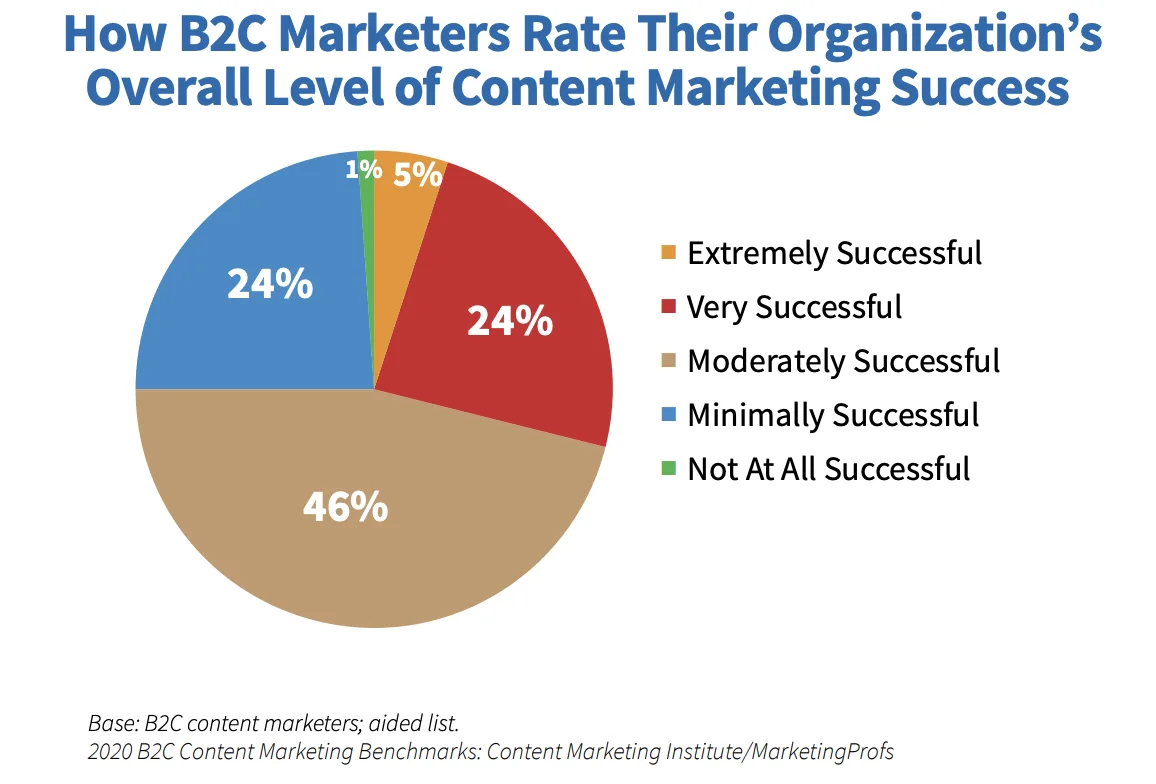
“Videos, blogs, and social postings that show your products in action create opportunities for your customers to relate and identify a need in their own lives. It shows the type of person who uses your products and the context in which those products are valuable. Plus, it adds a certain amount of legitimacy to your brand, especially when your content has engagement from customers through blog comments, social media followers, and the like.”
— Ryan Garrow, Director of Partnerships & Client Solutions, Logical Position
Building SEO value.
Consistently publishing high quality content is one of the best ways to build brand and domain authority — with both your customers and with search engines. Just remember that this doesn’t happen overnight. It takes consistency, quality, and volume.
More posts mean more pages for Google to index, leading to more potentially ranking keywords. If you rank for more keywords, you’ll attract more inbound traffic.
“Invest in SEO as quickly as possible. With a new domain you may not see that organic traffic build for quite some time, but the faster you start the faster you can bring down that PPC budget.”
— Joe Chilson, Head Writer and Project Manager, 1Digital
Engaging prospects and customers without selling.
One of the keys to providing a smooth buyer’s journey is to begin by providing value and sparking engagement without a hard sell. Think of it as a service you’re providing that has the added benefit of keeping your brand top-of-mind.
“So many people are engaging with online influencers who are acting like brands. Brands need to begin acting like online influencers and building communities. The best way to do this is through content.”
— Steve Deckert, Co-Founder, Smile.io
If you’re providing content that is valuable to consumers, they’ll keep returning to your site even if they don’t plan to make a purchase — and that is the foundation of a long-term relationship.
“Your potential customers have already given you some indication that they want what you have, so by offering videos of your product in use, sizing charts, or an infographic on features, you are putting yourself ahead of your competition and giving your potential customer that much more of a reason to convert and make a purchase.”
— Tessa Wuertz, Director of Marketing, efelle creative
Establishing authority.
To build trust among your prospects and customers, you want to establish your brand as an authority in your vertical. If you’re selling outdoor products, for instance, your target audience will trust you more if they know you can answer their questions about those products or related activities.
“There are a lot of things that content marketing can accomplish, but at its core content marketing enables you to build trust with your consumers/customers. You’re the expert. Convey that to your customers and the ROI will come back in droves.”
— AJ Silber, Founder, The Guerrilla Agency
What is a Content Marketing Strategy (And Why Do You Need One)?
A content marketing strategy should be a high-level roadmap detailing your target audience, goals and key performance indicators (KPIs) for your content, and how those goals align to the needs of the broader business. It should also provide a broad outline of the content creation process — how your organization plans to ideate, produce, manage, and measure your content analytics.
“Tons of ecommerce brands are making a killing with Facebook ads and Influencer marketing. The problem is once you stop the ads, the sales will stop too. This is why a long-term content strategy is so important. Not only can you get long-term traffic, but you can tell a better story through branded content. Powerful content can amplify your advertising effectiveness and also position you for long-term organic traffic.”
— Darren DeMatas, Founder, Ecommerce CEO
It’s important to take the time to document your content strategy. Having a documented strategy can make your organization’s efforts more successful, and it’s also a sign of a more sophisticated content organization.
In the Content Marketing Institute’s B2C survey, only 33% of all respondents reported having a documented content strategy. But, of the respondents belonging to a mature content organization (you can read the full report for more information on how the institute defines “mature”), more than half had documented their strategy.
9 Step Plan to Develop an Effective Content Marketing Strategy
The best content marketing plan will balance what your audience wants to know with what you want them to know (your marketing message).
1. Establish your goals.
While just about every brand can benefit from content marketing, your reason for putting time and effort into content can’t be, “Just because.”
“I think there’s a lot of brands out there today and even small businesses that are thinking, I need to get into content because that’s what everyone else is doing. But really you need to figure out why content is important to you and to the success of your brand.”
— Alex Kubo, VP of Ecommerce and Digital Marketing, Burrow
You should establish content marketing goals, align them to broader marketing and business goals, and determine the metrics you’ll use to measure success. If you do this at the very beginning, you can map all your subsequent efforts to those goals and make the best use of your time.
2. Know your audience.
You won’t effectively be able to generate content that resonates unless you have a clear understanding of who you’re trying to reach. Creating buyer personas is a popular method of distilling information about your target audience, like:
Demographic information like gender, income, marital status, etc.
Hobbies they participate in or communities they are a member of
Where (or from who) they get their information about products and services
What goals they are trying to achieve when they purchase your product
How they make decisions about what products they will purchase
It’s okay to not have all of this information right away; just flesh out an image of your ideal buyer as much as you can, and make sure you’re creating the content they need. To learn more about your audience, you can conduct surveys or “listen” to conversations on the social media channels they frequent.
It’s also a great idea to have one-on-one conversations with customers and prospects — this will give you unrivaled insight into their motivations, and probably result in more than a few new content ideas.
3. Map the buyer’s journey.
Because serving the right content at the right time is so important, you also need to know how your customers move through the path to purchase. This will differ between B2B and B2C, and also by vertical.
Large, pricey purchases will likely have a longer buyer’s journey and include more research and product comparisons. These buyers will need more extensive information from you and have more questions that you need to answer. Small, inexpensive items may be purchased (or forgotten) in the blink of an eye, so bite-sized content may be more effective.
Once you have a clear understanding of how your customer makes purchasing decisions, you can map your content to their pain points and answer their questions before they have to ask.
4. Identify what differentiates you from your competitors.
One of the most important foundations for your content strategy is a clear understanding of what makes you different from your competitors. A competitive analysis can help you clarify what your competitors are doing and saying. Compare your messages and proof points to theirs. Find the areas that make you unique and give you an advantage and make content focused on that message.
5. Build your brand narrative.
Consumers identify with stories. One of the keys to a lasting brand and loyal fan base is a story that customers can connect with. Storytelling works because it connects facts with emotion, and it’s that emotion that will lead to loyalty down the line.
“Big brands are now under attack from smaller brands/start-ups who have a story…it’s a way of making your brand feel real and approachable, and so large brands need to connect with consumers too in order to make themselves approachable too. Therefore by go ing direct to consumers, brands are able to create and nurture relationships with customers rather than be this untouchable and unemotional behemoth.”
— Luigi Moccoa, Founder of Calashock
Line Skis knows the power of a brand narrative in connecting with their audience. The example below is from their About page, and in just two paragraphs and one image, they speak volumes about who they are and what they’re about. Line doesn’t need to sell to everyone — they have a target market, and they’re not afraid to speak directly to them.

6. Inventory and audit existing content.
If you’re working on a content marketing plan but already have a good deal of content, before you go any further, do a content audit to make sure you know what you already have. Then, review it for quality and relevance. (This should be done regularly, whether you’re developing a new strategy or not.) You can use Google analytics or other analytics platforms to identify your most successful content.
7. Define your content mix.
My favorite marketing maxim is, “Just because you can — doesn’t mean you should.” But the reverse is also true: Just because you should, doesn’t mean you can. Identify the content types that resonate best with your audience and the ones you and your team can do well. Where there is overlap, those are the content types you should invest in.
“My recommendation would be to invest more time and effort into a main set of categories, build out buyers guides, and other content that supports those key categories, and you are likely to see better traffic increases than if you were to build thin content across a wider range of categories and pages.”
— Corey Dubeau, VP Marketing, Northern Commerce
8. Plan your editorial calendar.
You may have heard of the concept of “Big Rocks” in the productivity world. You can use that concept as you start to plan your content calendar. By starting with the “Big Rocks,” or the most substantive content you have planned, you can build in everything else around it.
Your Big Rocks should be clearly aligned to your audience and goals, meeting their highest needs. You can then turn those substantive pieces of content into derivative pieces. For example — if you have a buying guide, maybe there’s a piece of information in it you can turn into an infographic or engaging social post. Maybe it can spin off into a couple of blog posts.
This not only contributes to a cohesive content marketing message — it also maximizes the value of your team’s time and energy.
Make sure you don’t forget about timely events, holidays, and specials that are important to your brand.
9. Maintain your content.
Before getting too far along with your content plan, make sure you have processes and workflows in place to help you maintain it. You’ll want to schedule regular content inventories and audits, make sure you have a plan in place to update and repurpose content where possible, and measure performance.
“Once you create a piece of content, it’s not just a forever asset, it’s something that you need to continue and iterate on, just like any other part of your marketing strategy.”
— Alex Kubo, VP of Ecommerce and Digital Marketing, Burrow
3 Examples of Great Content Marketing in Ecommerce
With content marketing, there’s a huge breadth of activities to consider and a range of levels of creativity. Let’s walk through some of the most creative examples out there!
1. Skullcandy.
Skullcandy, a brand focused on high-quality headphones, earbuds, and speakers, has an innovative content marketing program they began after launching their new website on BigCommerce.
Speaking to two primary audiences — music lovers and athletes (and, of course, where they intersect) — they feature one new artist, one professional athlete, and one limited edition product each month to align with a selected mood.
“Coinciding with the launch of our new website, we accelerated the introduction of a new brand campaign, spinning up an “All Access Pass” experience to bring the “Now Feel This” livestream concert series and “You Feel Me?” podcast series online to highlight emerging artists and athletes,” said Mark Hopkins, Chief Information Office of Skullcandy.
“In addition, we’ve taken the learnings from these initiatives and rolled out the 12 Moods program this year and it’s off to a great start. Each month we’ll release a product in a limited edition color to reflect the month’s mood and we’ll feature an artist and athlete as well.”
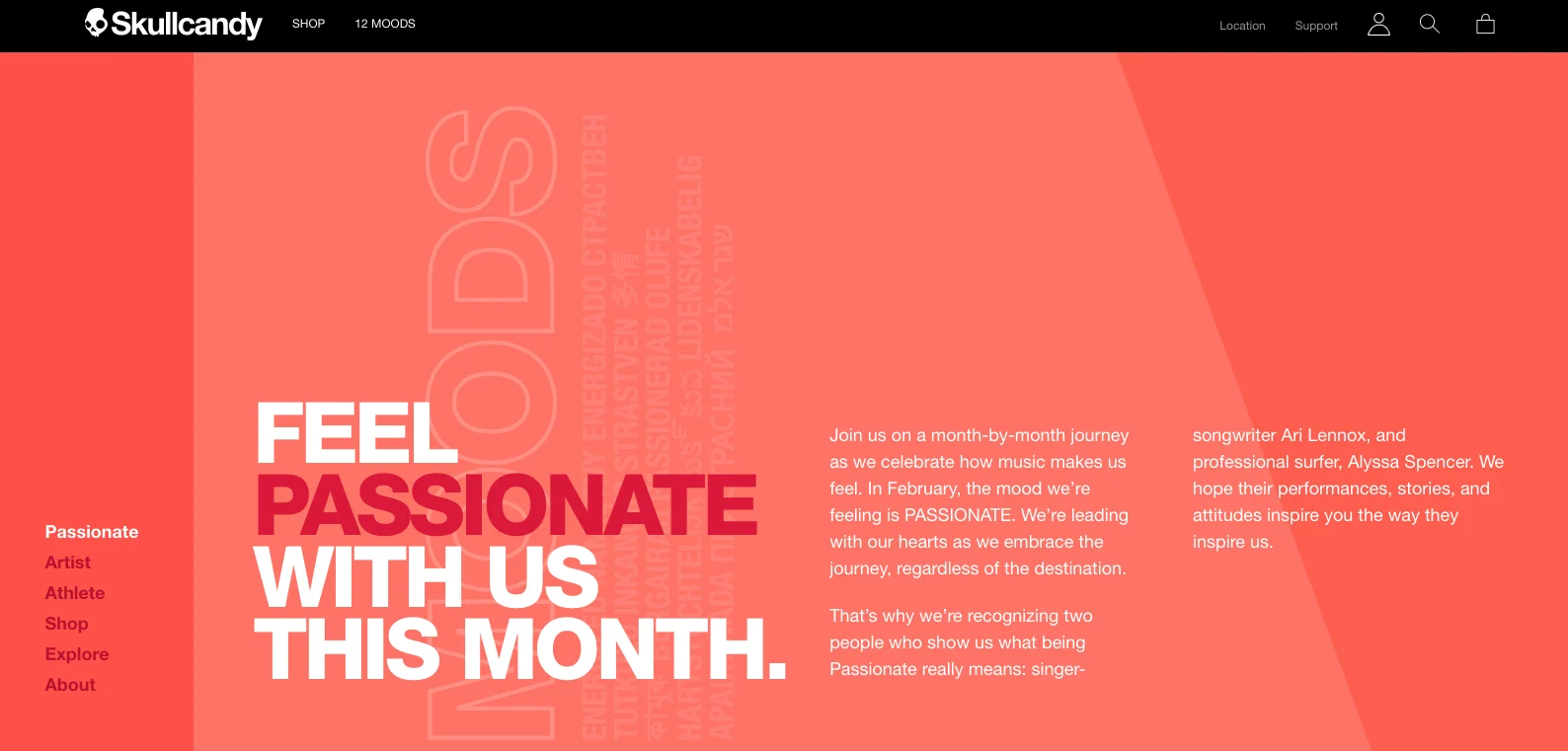

Both the athlete and the artist page include vibrant lifestyle photography. While some of the photos do feature Skullcandy’s products, it’s a relatively subtle product placement that allows the content to truly focus on the featured subjects. The artist page also includes several videos to feature exclusive live performances and behind the scenes.
With 12 Moods, Skullcandy does what I love best about content marketing — figuring out what they’re really, foundationally about and doubling down. They sell ways to listen to music, for people who love music. By providing value-add content that appeals to that audience, they can build a community and keep them coming back for more.
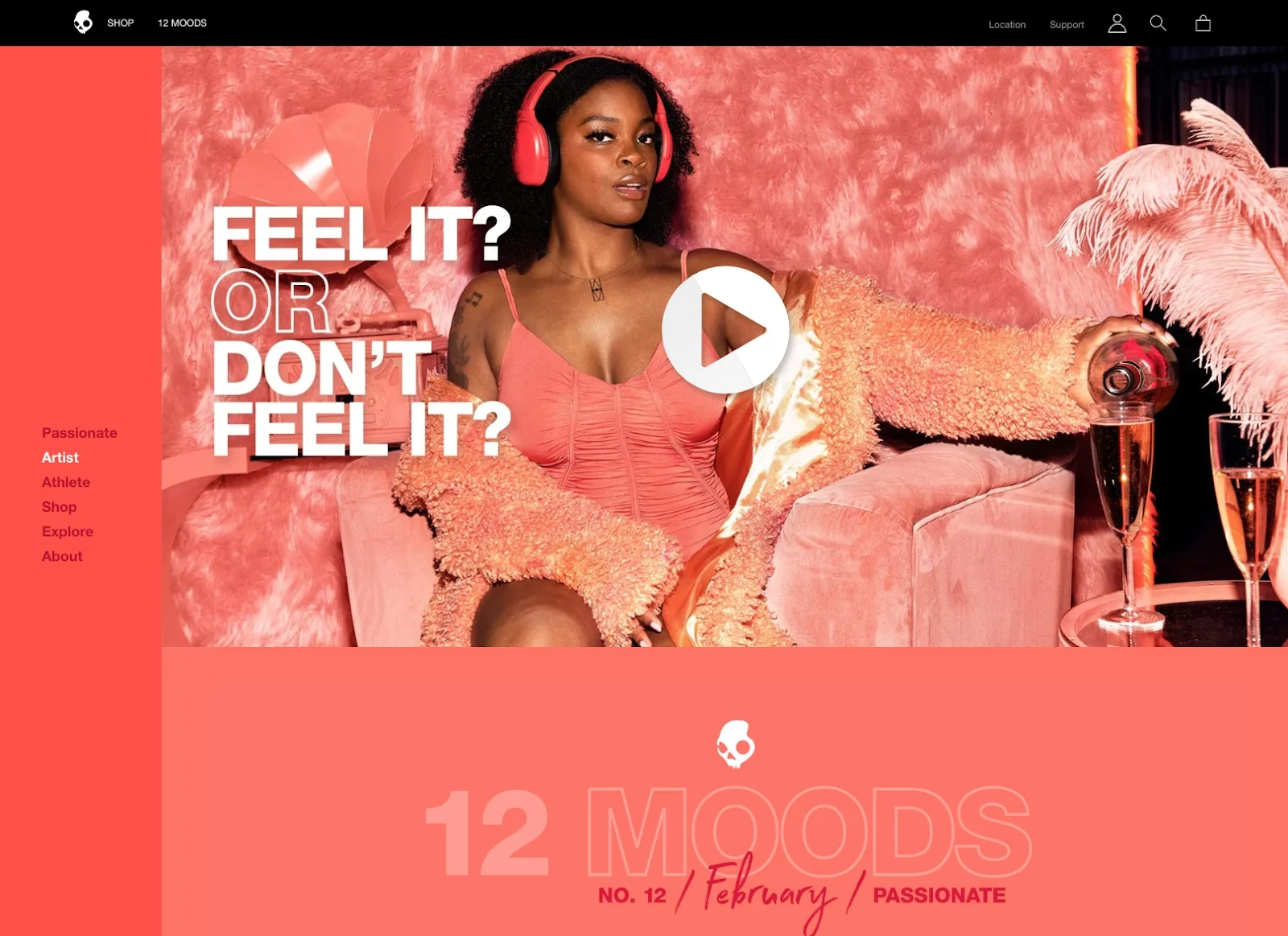
Social media content aligns with this program each month to promote that month’s mood, artist, and athlete, sprinkling in product-specific posts with photography that carries through the monthly look and feel.
Here’s my favorite part, though. They don’t just focus on the innovative program — they use every landing page as a place to tell their story and make their customers feel like part of the brand.
Product pages feature rich content that helps to alleviate the challenge of buying a product that relies on a sense that doesn’t fully transfer through a screen. They start with vibrant photography (for each color of the product) and a list of the features most important to their audience.
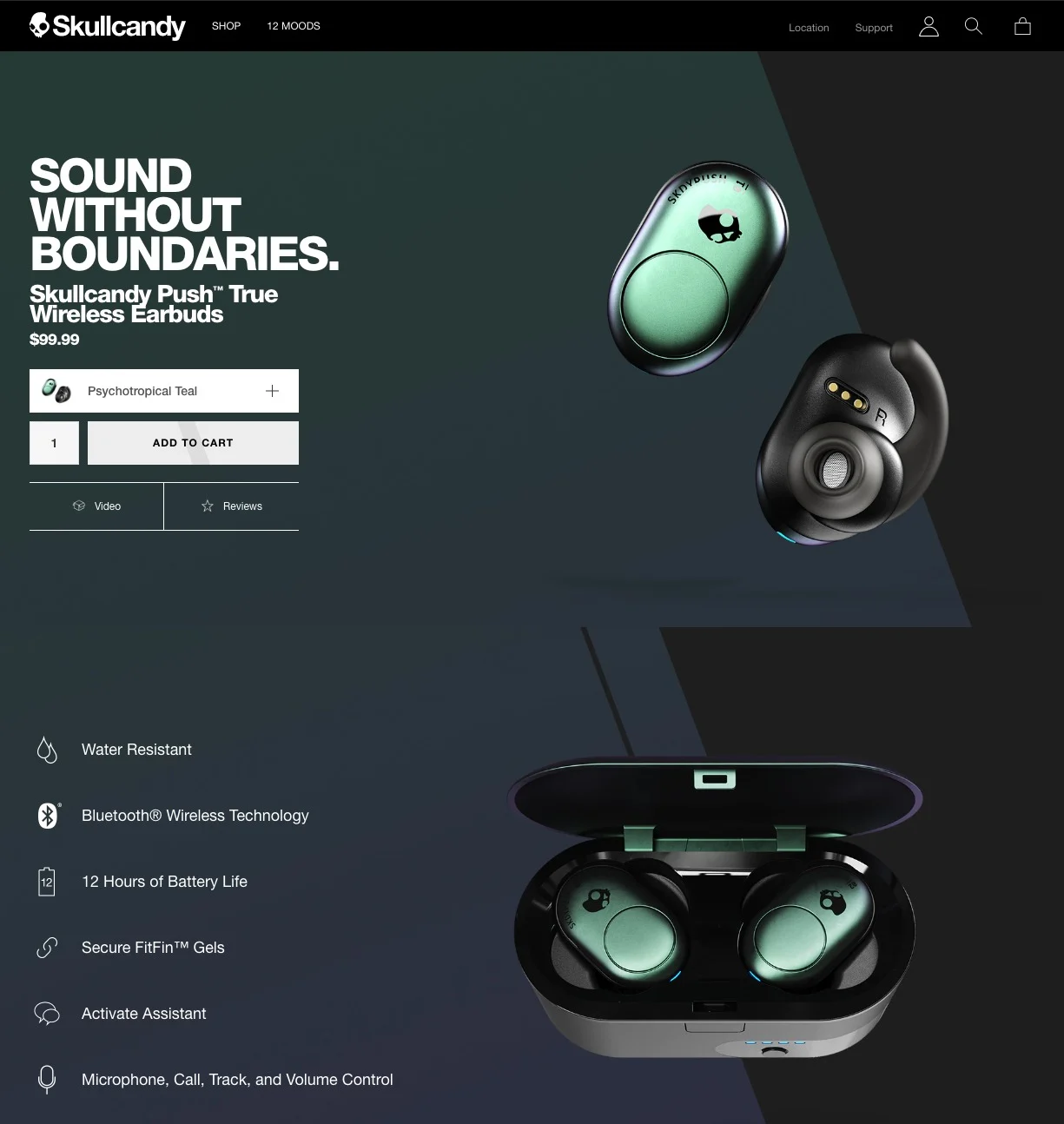
Below the features, product pages include a video — or even two — showing the product in action and connecting it to Skullcandy’s brand story. They continue with more feature blocks to drive home the larger marketing messages and most important features.
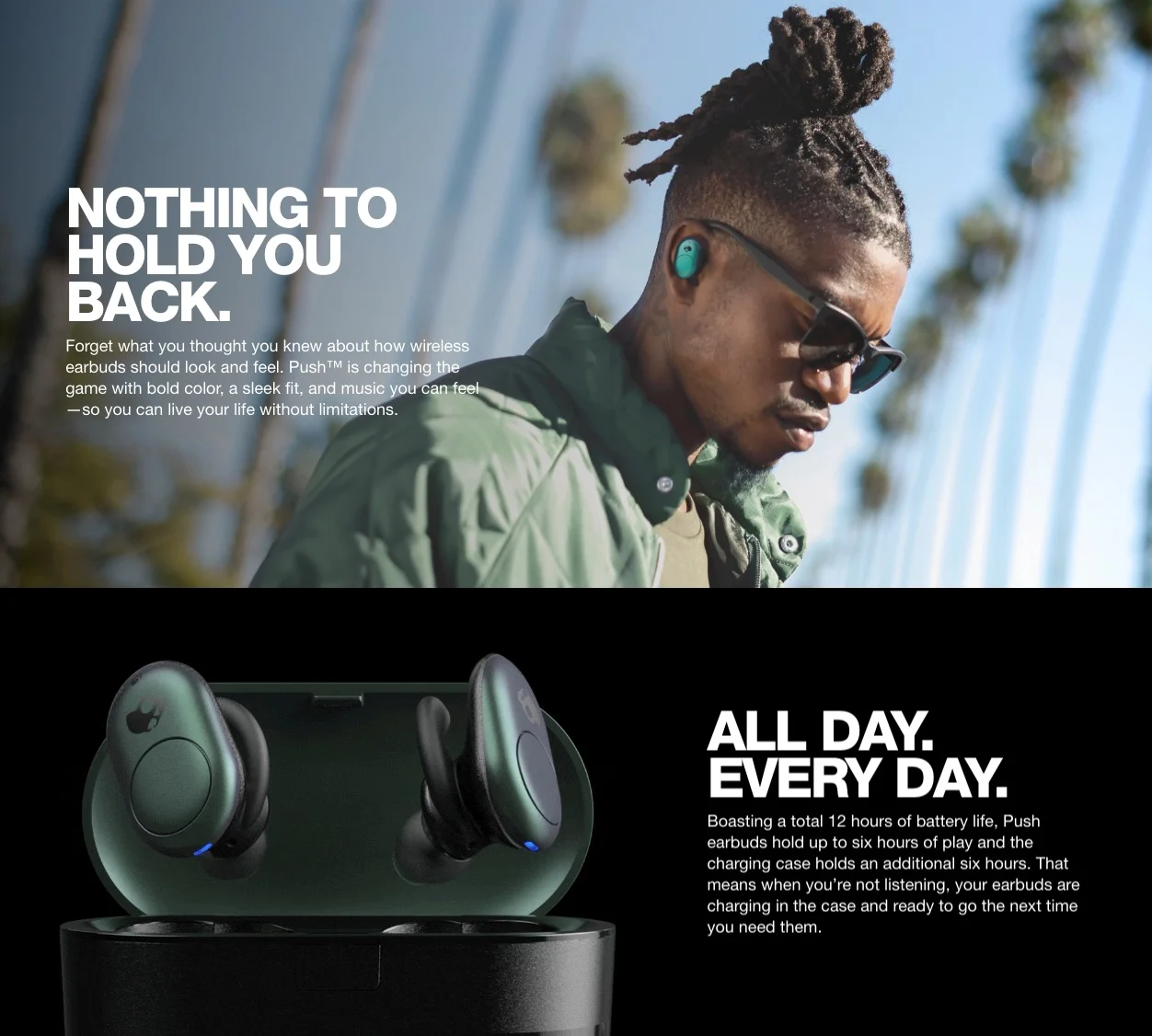
Also, that image on the bottom left in the above? It’s animated. Just another added touch to pull in shoppers’ attention.
In some ways, moving down the page is like moving down the funnel. After these more feature-focused, marketing-centered messages, they get into the nitty gritty details of functionality.
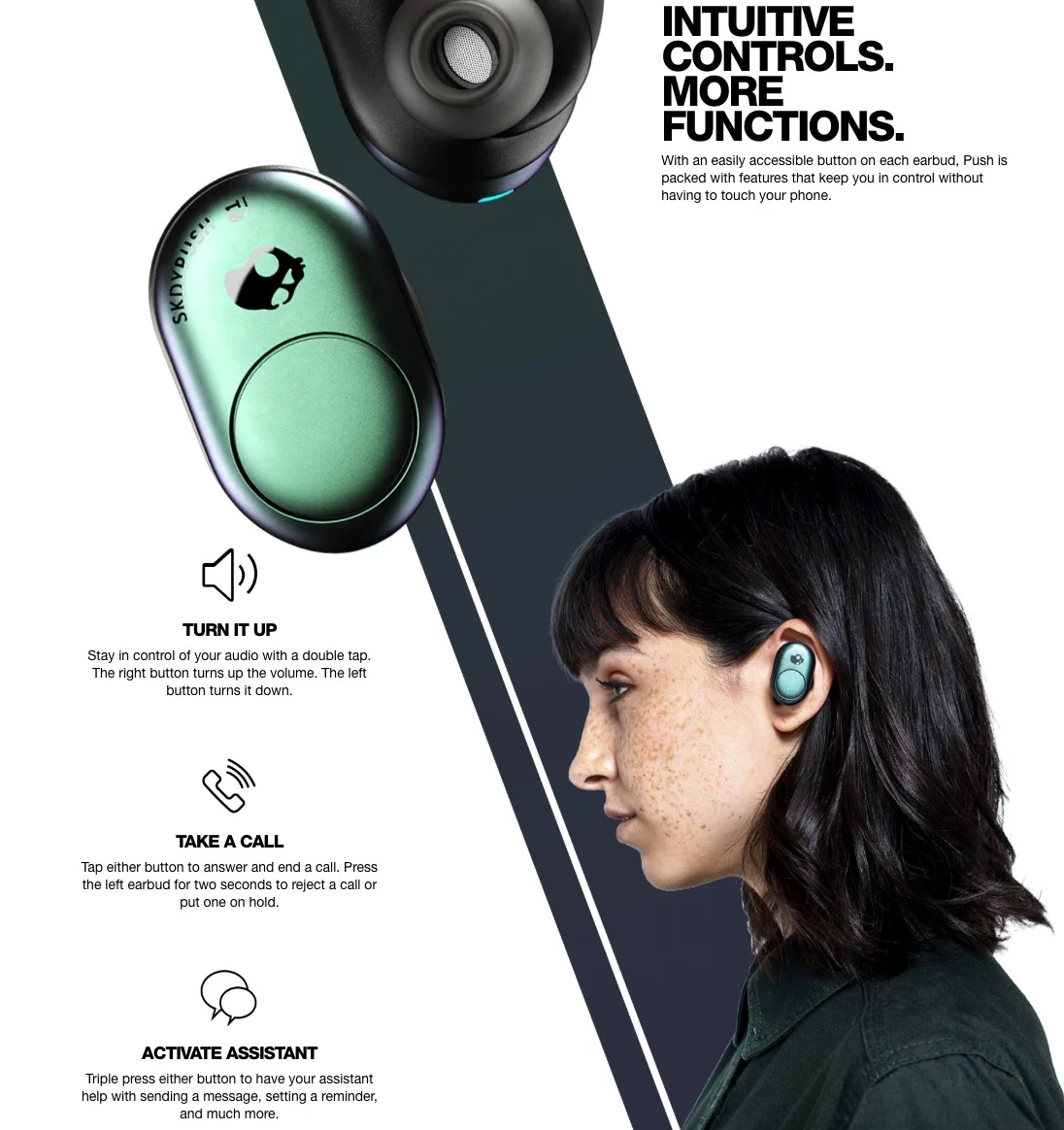
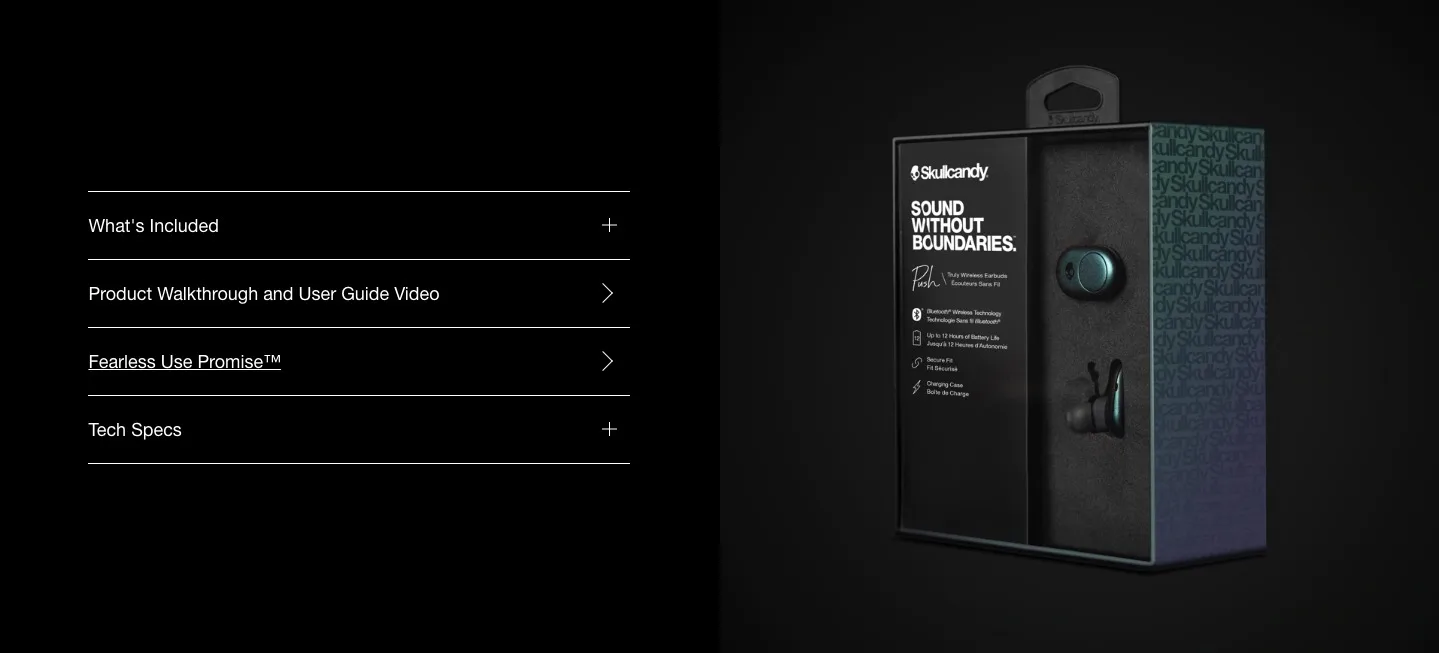
Finally, on the very bottom of the page, they introduce the social proof with a reviews section.
While these elements of the product page are unique to each product, Skullcandy also takes the opportunity to let their overarching brand narrative shine through with a couple of common elements. This helps to reinforce who they are while also speaking to the customer as they are — even if they don’t visit the “Our Story” page, which communicates their brand narrative in a more complete way.

They also have their own podcast, too. Because of course they do!
One last point: Skullcandy offers a fully built-out support section with setup videos, user guides, and troubleshooting information so that customers don’t have to call with questions. They recognize that most Millennials would rather seek out information for themselves instead of picking up the phone.
2. Canvas 1839.
CBD brands are an example of an industry that needs content marketing. Because it’s such a new industry, consumers may need more education on the products to make an informed purchase. BigCommerce CBD merchant Canvas 1839 doesn’t just have a beautiful website (but they seriously do), they do a great job of educating and entertaining their visitors.
First, the basics. What is CBD, and what does it do? How does it work? Is it the same thing as marijuana? Canvas 1839 provides a wealth of information and FAQs to arm shoppers with this information early and clearly.

Quality assurance is important in the CBD industry — particularly to ensure their compliance with current legal standards. Canvas 1839 has a page on their ecommerce site dedicated to detailing their ingredients, their origin, and related reviews and test results.
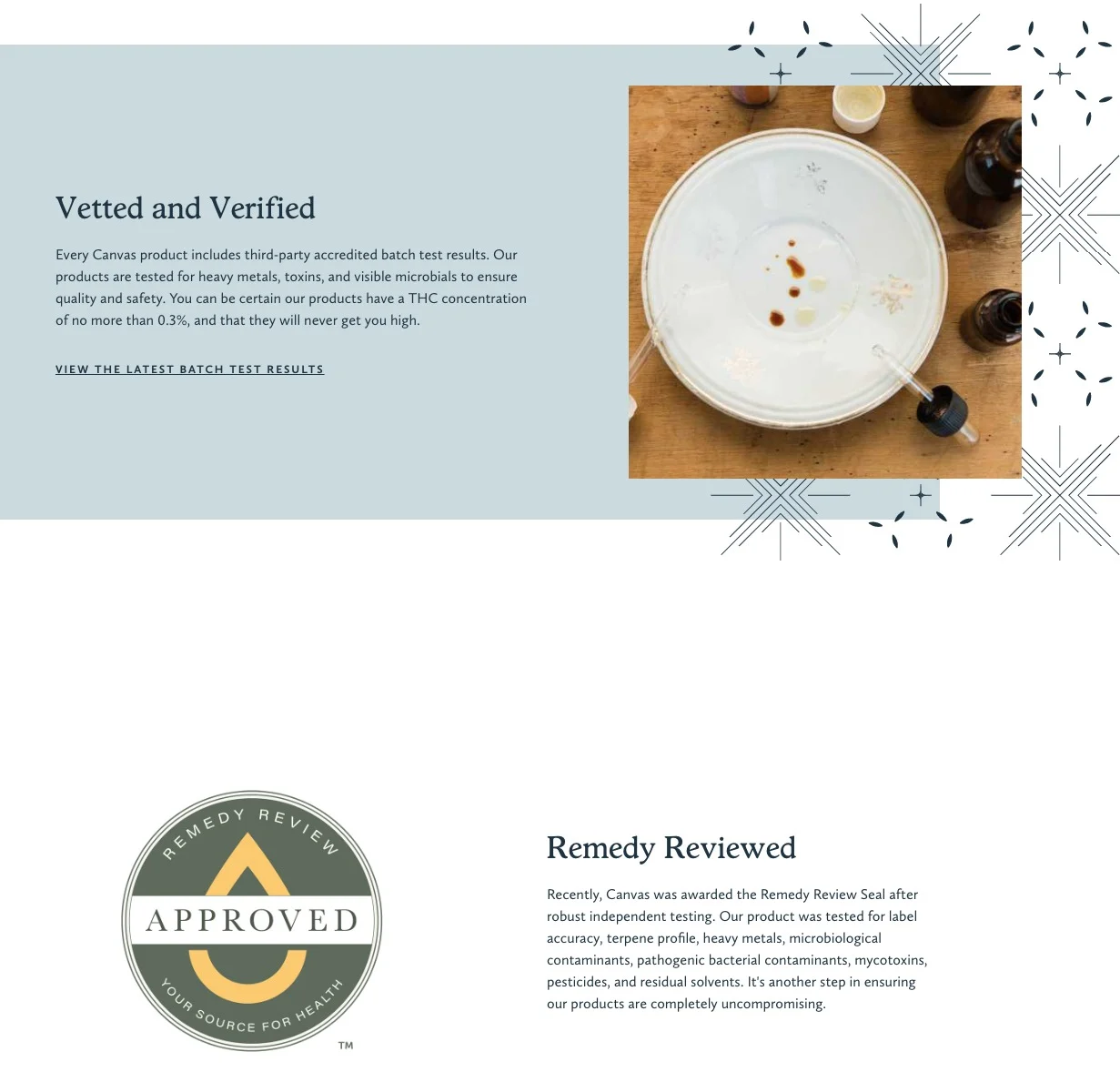
They also have an interesting approach to blog content that serves two purposes. In their “Magazine” section, they have articles in two categories: CBD 101 and Wellness. If you go to “Magazine,” all the articles show.

But there’s also a link in the navigation to “CBD 101” — which goes to the magazine but shows only the CBD 101 articles. This allows them to provide educational content and related lifestyle material, but to separate the scientific content in a way that serves the shopper looking for unbiased information.
Here’s an example of their CBD 101 content: “What is a CBD Tincture?” These articles build trust by clearly communicating that they are scientifically reviewed and fact-checked.

The Wellness content adds value by providing additional articles on stress reduction, sleep hygiene, and managing anxiety, to name a few — topics that are top-of-mind with their target CBD customer.
3. Passion Planner
Passion Planner is a BigCommerce merchant that doesn’t just make beautiful planners. They create community and inspire loyalty among their customers — or, #PashFam.
The cornerstone of content marketing is providing valuable content for free, without a sales pitch. Passion Planner generously offers its page layouts for free in printable PDFs.
Signing up for their email newsletter is rewarded with a free 3-month Passion Planner PDF and downloadable inserts like habit, water, and workout trackers. The introductory email also features a short video series on how to use the planner.

Passion Planner’s investment in video has garnered high engagement. Their YouTube channel, featuring how-to videos, productivity hacks, and more, has nearly 30,000 subscribers. While the videos often feature the planner, they don’t have a sales pitch — they add value by providing tips and tricks that enhance customers’ experience and can also be useful to anyone looking to organize their lives (even using another planner).
The brand’s blog features inspirational articles on productivity, tips on how to use the planner, and more.
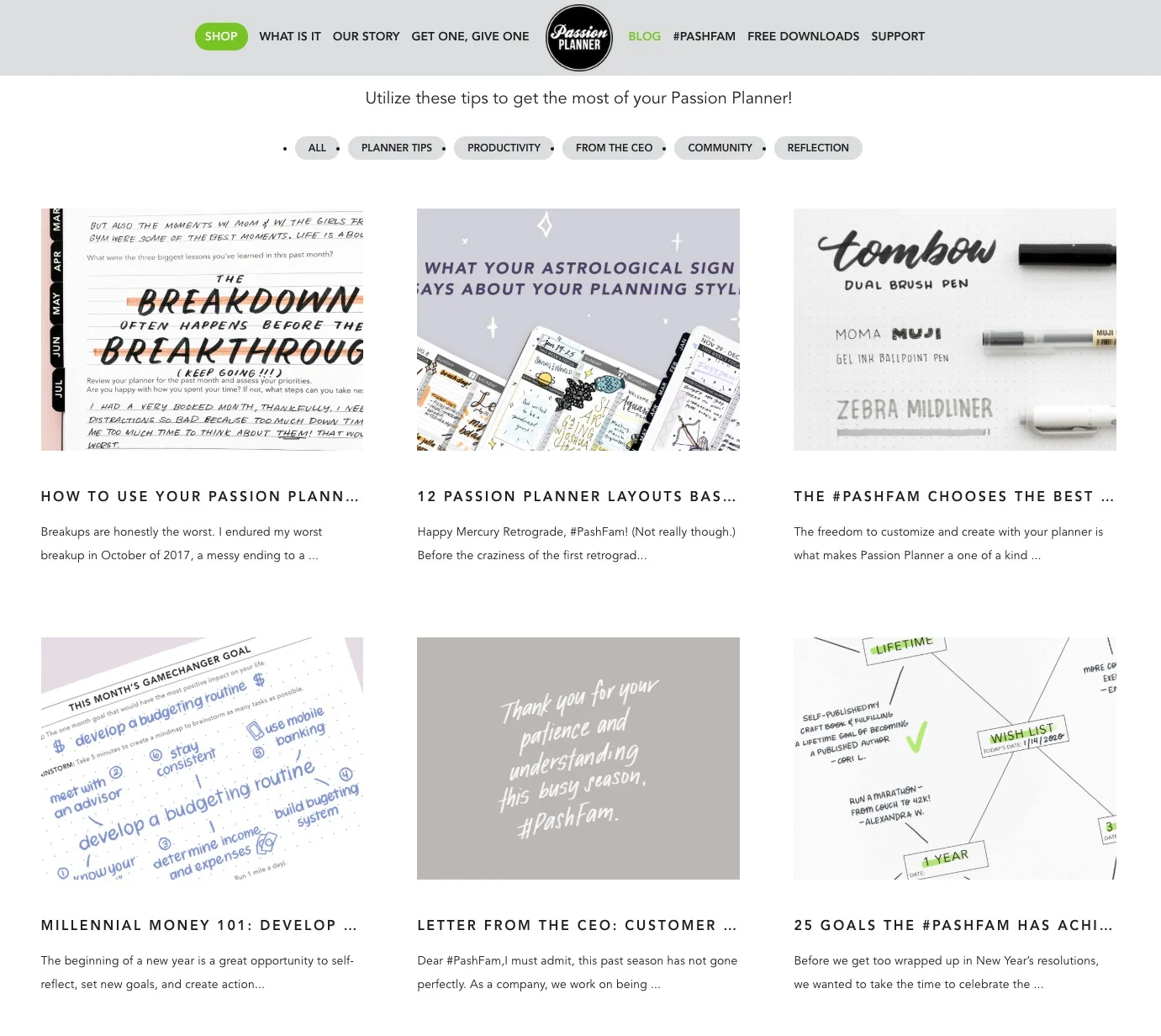
The themes in the blog carry over into their social media channels, where they post more planner inspiration and tips. Their Instagram account has 386,000 followers — evidence of the size and strength of the #PashFam community, as well as the demand for this type of content.
Passion Planner taps into the power of that community by utilizing user-generated content. With a simple online form, they make it easy for the #PashFam to share their success stories. Then, the brand is able to showcase these powerful customer testimonials and bring visitors into the #PashFam fold.
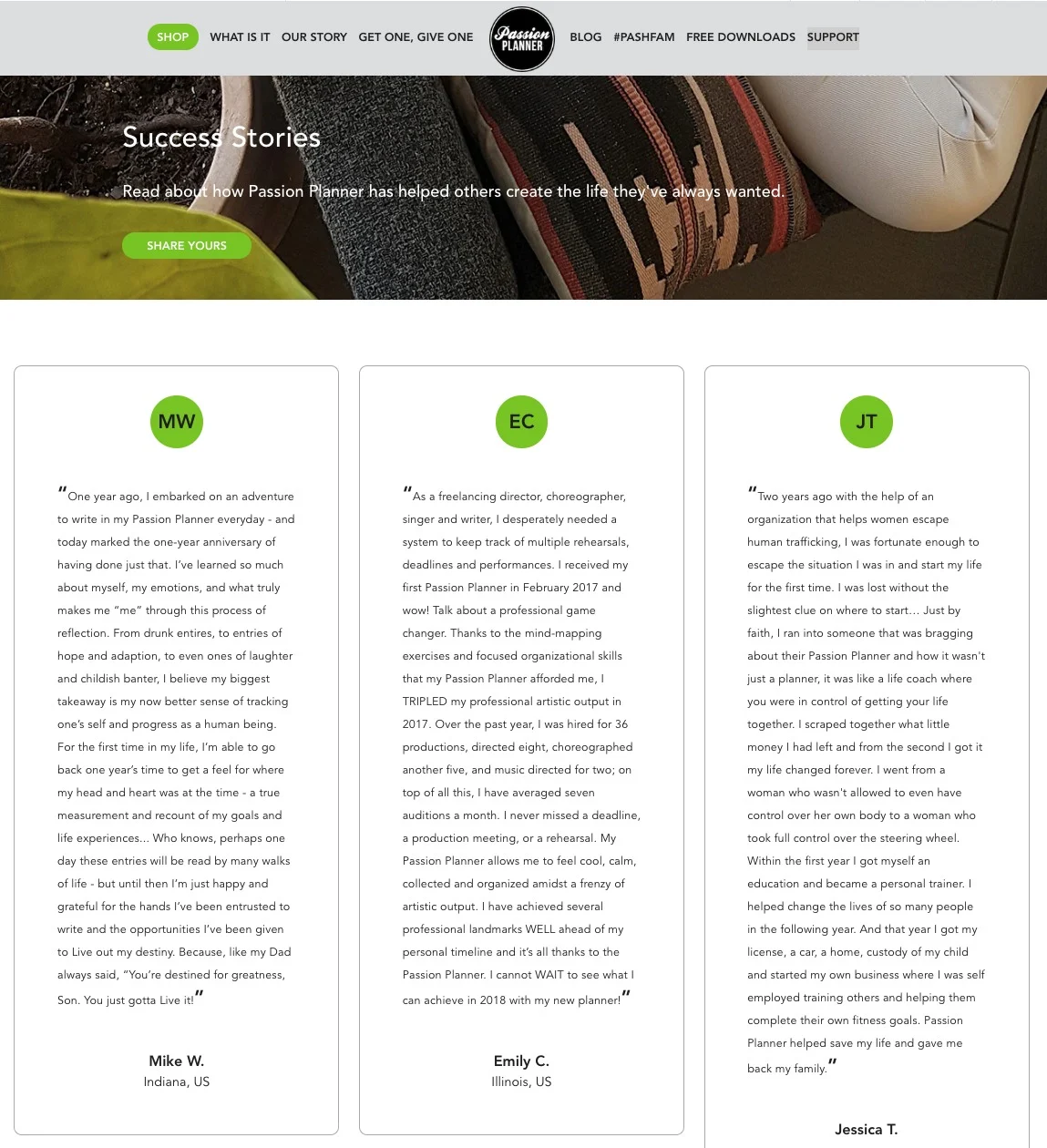
Marketing Director Jamie Santos says, “We were able to surpass $1,000,000 in revenue by investing in our community, our biggest asset, the #PashFam. Our #PashFam blog showcases real people who strive for growth and are passionate about helping those around them. We truly believe in these people and who they are. We feel lucky to support them by providing the resources they need to create the lives they’ve always wanted.”
Conclusion
If there’s one thing you should take from this, it’s not necessarily that content marketing works — it’s that you need a strategy. Without a strategy, it might not work. If you’re just dipping your toe into the content marketing water, step back for a minute and think about the big picture.
You need to fully understand your audience, your goals, and your differentiating value propositions. Putting in the time and effort it takes to run a content marketing operation is a big investment, and you want to make sure you’re maximizing that investment to see significant returns.
Whether you’re new to content marketing or just looking to improve your ROI, you can benefit from developing and documenting your strategy and the processes for executing on it. Once you have the seeds of a great strategy, you can start cultivating your content and watching your business grow.

Victoria is a content marketing writer, researcher, and content project manager at BigCommerce. Specializing in writing and web content strategy, she previously spent eight years in public relations and marketing for Tier I research universities. She holds a B.A. in English Writing and Rhetoric from St. Edward’s University and a Master of Liberal Arts from Lock Haven University of Pennsylvania.


